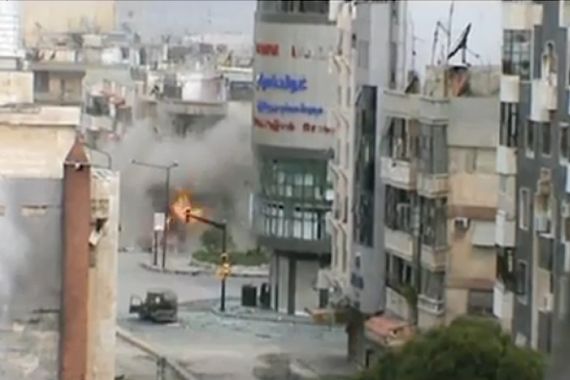Fresh clashes in Syria ahead of UN mission
Reports of violence near Damascus and across the country as UN team expected to monitor April 10 ceasefire deadline.

Fierce clashes have been reported between Syrian government forces and opposition fighters in Douma, near the capital Damascus, and in other parts of the country, amid doubts over the government’s declared commitment to meeting an imminent ceasefire deadline.
UN Secretary-General Ban Ki-moon said on Thursday that violence against civilians had not stopped and the year-long conflict was getting worse.
“Despite the Syrian government’s acceptance of the joint special envoy’s [Kofi Annan’s] plan of initial proposals to resolve the crisis, the violence and assaults in civilian areas have not stopped,” Ban told the UN General Assembly.
“The situation on the ground continues to deteriorate,” he said.
The continuing violence comes as a UN monitoring team led by Major General Robert Mood is expected in Damascus on Thursday to review the government’s promise of a troop withdrawal to army bases by April 10.
Major General Mood is a former chief of staff of the Norwegian armed forces and former head of the UN’s Jerusalem-based UNTSO Middle East peacekeeping mission.
The UN Security Council is calling on Syria “to urgently and visibly” fulfill its pledge to halt the use of troops and heavy
weapons in cities and towns by 6am Syria time on April 12, giving the government and opposition groups 48 hours to end all hostilities.
The UN is already asking member nations to contribute about 200 to 250 soldiers who would monitor the ceasefire.
Challenge for Annan
Annan said the government had told him it had started a “partial withdrawal” from Idlib, Zabadani and Deraa. But he told the UN General Assembly that it had not been confirmed and there were “alarming levels” of deaths still being reported.
The Syrian Observatory for Human Rights said on Thursday that Syrian troops backed by tanks stormed Douma at dawn amid heavy gunfire and shelling.
The UK-based activist group said clashes between soldiers and rebel forces were reported in various parts of the city, which is located about 10km northwest of the capital.
Activists in Douma said snipers on 20 buildings were firing at “anything that moved” and that residents had endured eight hours of shelling. They said soldiers marched into a main square behind detainees used as human shields.
Plumes of smoke could be seen rising near the city’s main mosque as troop reinforcements were sent in, the group said.
Two young men were killed early on Thursday in Kfar Sousa, a neighbourhood of Damascus, when security forces opened fire on their car, the Observatory said.
Activist groups reported at least 33 people, including 14 soldiers, killed on Thursday, 16 of them in the city of Homs and 14 in Idlib province, along with more than 50 dead nationwide on Wednesday.
Violence across the country has left at least 170 people dead so far this week, despite a pledge by President Bashar al-Assad to implement a peace plan brokered by UN-Arab League envoy Kofi Annan.
Annan is expected to visit Iran on April 11 to discuss the peace efforts with the nation’s leaders, who have been steadfast in their support for the Assad government.
“The [Syrian government’s] track record is that it responds gingerly and slowly to regional and international pressure – then gives in just enough to gain more time,” Rami Khouri of the Issam Fares Institute told Al Jazeera.
“The likelihood is that they will continue to give in to some of the demands of the Annan plan. But the context is different now, with the Chinese and Russians pushing for the plan to go ahead.”
Fighting continues
Meanwhile, five soldiers were killed in two separate attacks in the northern province of Aleppo and in southern Deraa, the cradle of the revolt that broke out last March against Assad’s government. Clashes were also reported in several towns in Aleppo province.
“The Syrian army is bombing all around the governates of Idlib and Aleppo,” Al Jazeera’s Anita McNaught said, reporting from the Turkish-Syrian border. “Families able to are fleeing to Turkey for safety.”
Our correspondent also said, “The way the Syrian army has positioned itself now is to cut off escape routes,” and that there are no signs fighting has halted.
McNaught also added that shabiha thugs are likely to remain as undeclared pro-government forces even when the visible army units pull out.
The US on Wednesday criticised the “intensification” of violence against opponents of the regime, despite Assad’s pledge to implement Annan’s six-point peace plan by April 10.
“We’ve yet to be convinced that they have any intention of complying with the April 10 deadline,” US State Department spokesman Mark Toner told reporters.
The unrest in Syria has left more than 9,000 people dead since last year, according to UN figures, raising fears that the unrest could spill into outright civil war.
The UN also says one million Syrians are in need of humanitarian assistance and that tens of thousands are seeking refuge in neighouring countries.
Sergei Lavrov, Russia’s foreign minister, said on Wednesday that under-equipped rebels would never be able to defeat Syria’s military, and warned of interminable bloodshed if the violence continued.
“It is clear as day that even if the Syrian opposition is armed to the teeth, it will not be able to defeat the government’s army,” the Interfax news agency quoted Lavrov as saying while on a visit to Azerbaijan.
“Instead, there will be carnage that lasts many, many years – mutual destruction.”